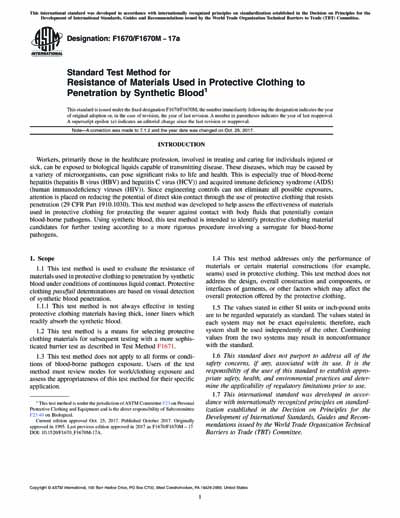Historical
ASTM F1670/F1670M-17a
Standard Test Method for Resistance of Materials Used in Protective Clothing to Penetration by Synthetic Blood
1.1 This test method is used to evaluate the resistance of materials used in protective clothing to penetration by synthetic blood under conditions of continuous liquid contact. Protective clothing pass/fail determinations are based on visual detection of synthetic blood penetration.
1.1.1 This test method is not always effective in testing protective clothing materials having thick, inner liners which readily absorb the synthetic blood.
1.2 This test method is a means for selecting protective clothing materials for subsequent testing with a more sophisticated barrier test as described in Test Method F1671.
1.3 This test method does not apply to all forms or conditions of blood-borne pathogen exposure. Users of the test method must review modes for work/clothing exposure and assess the appropriateness of this test method for their specific application.
1.4 This test method addresses only the performance of materials or certain material constructions (for example, seams) used in protective clothing. This test method does not address the design, overall construction and components, or interfaces of garments, or other factors which may affect the overall protection offered by the protective clothing.
1.5 The values stated in either SI units or inch-pound units are to be regarded separately as standard. The values stated in each system may not be exact equivalents; therefore, each system shall be used independently of the other. Combining values from the two systems may result in nonconformance with the standard.
1.6 This standard does not purport to address all of the safety concerns, if any, associated with its use. It is the responsibility of the user of this standard to establish appropriate safety, health, and environmental practices and determine the applicability of regulatory limitations prior to use.
1.7 This international standard was developed in accordance with internationally recognized principles on standardization established in the Decision on Principles for the Development of International Standards, Guides and Recommendations issued by the World Trade Organization Technical Barriers to Trade (TBT) Committee.
Content Provider
ASTM International [astm]






